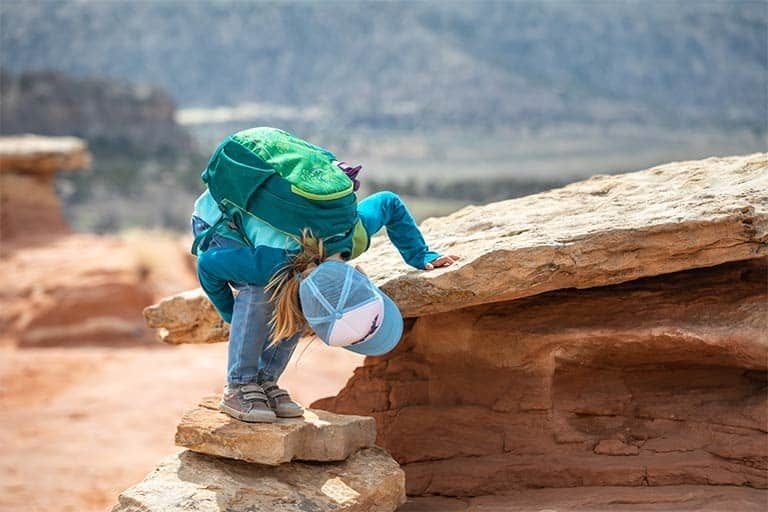Share on

Sustainability > Osprey: Progress, Transparency, Sustainability

Sustainability > Osprey: Progress, Transparency, Sustainability

By Stéphanie Major
1 June 2022
No surprise that Osprey has environmental goals that are as big as the outdoor world itself: “become the most progressive, transparent and sustainable outdoor gear brand in the world.” The plan is to tackle three categories: materials, chemical use, and product end-of-life.
From spring 2022, 60% of all main-body Osprey bag materials will be sourced from recycled materials. The difference between using new and recycled material in production is anticipated to be a 40-50% reduction in environmental footprint.
Recycling keeps material out of landfills and the ocean; reduces toxic incinerator emissions; reduces our dependency on petroleum, used in the manufacture of raw materials; and recycling uses less energy in processing material.
Osprey is complying with the Global Recycled Standard (GRS), which involves third-party verification of sustainable, high-quality recycled content. This oversight will also include packaging, already made of 100% recycled and recyclable polyethylene.
In addition, 65% of materials used by Osprey are bluesign certified. This internationally recognised certification manages the impact of fabric production in terms of the chemicals it requires, the people it employs, the factories it uses, and its effect on the environment. Materials bearing the bluesign-certified standard have met strict ecological and toxicological standards.
Durable Water Repellent (DWR) treatments prevent water from saturating a fabric. For a long time, they were made with PFCs (perfluorocarbons) which are toxic to the environment.
Compliance with the bluesign list of regulated substances, which restricts the use of chemicals in equipment or during its manufacture, will ensure minimal impact on people and the environment.
This approach, by virtue of its association with bluesign, is subject to inspection by a third party lab, which carries out chemical analysis and other spot checks. Osprey’s aim is to have its entire product range completely free of perfluorinated chemicals in 2022.

To limit the amount of waste produced by its operations, Osprey is working with Renewal Workshop towards establishing a circular production approach. The objectives are to give backpacks a second life, reduce the amount of product that ends up in landfill, and optimise their lifespan.
Renewal Workshop, which follows a zero waste programme, recovers equipment that is no longer in use and transforms it into renewed products, recycled materials or recycled raw materials. For example, the company cleans and repairs bags that cannot be sold as new, to make them fully usable. It assesses and classifies the products, cleans them using waterless technology, checks their quality and repairs them before reselling them. If the product cannot be repaired, then its materials will be reused in another way.
As of spring 2022, Osprey has diverted approximately 21,471 pounds of waste from landfill.

For many, an Osprey bag is the ultimate in hiking gear. The Osprey “all-powerful” guarantee is also invoked by hikers who used it to save a trip on a trail. Who knows, it may soon be you exploring the world that Osprey is doing its best to protect.
| Cookie | Duration | Description |
|---|---|---|
| _orig_referrer | 14 days | This cookie is set by website built on Shopify platform and is used in assoication with shopping cart. |
| cart_currency | 14 days | This is an essential cookie for the secure checkout and payment function on the website. This cookie is provided by shopify.com. |
| cart_sig | 14 days | This cookie is set by Shopify and is used in connection with store checkout. |
| cf_ob_info | This cookie is set by the provider Cloudflare. The cookie provides informations on HTTP Status Code returned by the origin web server, the Ray ID of the original failed request and the data center serving the traffic. | |
| cf_use_ob | This cookie is set by the provider Cloudflare content delivery network. This cookie is used for determining whether it should continue serving "Always Online" until the cookie expires. | |
| cookielawinfo-checkbox-advertisement | 1 year | The cookie is set by GDPR cookie consent to record the user consent for the cookies in the category "Advertisement". |
| cookielawinfo-checkbox-analytics | 1 year | This cookies is set by GDPR Cookie Consent WordPress Plugin. The cookie is used to remember the user consent for the cookies under the category "Analytics". |
| cookielawinfo-checkbox-necessary | 1 year | This cookie is set by GDPR Cookie Consent plugin. The cookies is used to store the user consent for the cookies in the category "Necessary". |
| cookielawinfo-checkbox-performance | 1 year | This cookie is set by GDPR Cookie Consent plugin. The cookie is used to store the user consent for the cookies in the category "Performance". |
| elementor | never | This cookie is used by the website's WordPress theme. It allows the website owner to implement or change the website's content in real-time. |
| secure_customer_sig | 1 year | This cookies is set by websites built on Shopify platform and is used in connection with customer login. |
| viewed_cookie_policy | 1 year | The cookie is set by the GDPR Cookie Consent plugin and is used to store whether or not user has consented to the use of cookies. It does not store any personal data. |
| Cookie | Duration | Description |
|---|---|---|
| pll_language | 1 year | This cookie is set by Polylang plugin for WordPress powered websites. The cookie stores the language code of the last browsed page. |
| Cookie | Duration | Description |
|---|---|---|
| _shopify_country | This cookie is used store and evaluate the preferred country settings opted by the visitor. |
| Cookie | Duration | Description |
|---|---|---|
| _ga | 2 years | This cookie is installed by Google Analytics. The cookie is used to calculate visitor, session, campaign data and keep track of site usage for the site's analytics report. The cookies store information anonymously and assign a randomly generated number to identify unique visitors. |
| _gat_UA-584276-11 | 1 minute | This is a pattern type cookie set by Google Analytics, where the pattern element on the name contains the unique identity number of the account or website it relates to. It appears to be a variation of the _gat cookie which is used to limit the amount of data recorded by Google on high traffic volume websites. |
| _gid | 1 day | This cookie is installed by Google Analytics. The cookie is used to store information of how visitors use a website and helps in creating an analytics report of how the website is doing. The data collected including the number visitors, the source where they have come from, and the pages visted in an anonymous form. |
| _landing_page | 14 days | This cookie is set by website built on Shopify platform and is used to track landing pages. |
| _s | 30 minutes | This cookie is associated with Shopify's analytics suite. |
| _shopify_s | 30 minutes | This cookie is associated with Shopify's analytics suite. |
| _shopify_y | 1 year | This cookie is associated with Shopify's analytics suite. |
| _y | 1 year | This cookie is associated with Shopify's analytics suite. |
| vuid | 2 years | This domain of this cookie is owned by Vimeo. This cookie is used by vimeo to collect tracking information. It sets a unique ID to embed videos to the website. |
| Cookie | Duration | Description |
|---|---|---|
| _fbp | 3 months | This cookie is set by Facebook to deliver advertisement when they are on Facebook or a digital platform powered by Facebook advertising after visiting this website. |
| ATN | 2 years | The cookie is set by atdmt.com. The cookies stores data about the user behavior on multiple websites. The data is then used to serve relevant advertisements to the users on the website. |
| fr | 3 months | The cookie is set by Facebook to show relevant advertisments to the users and measure and improve the advertisements. The cookie also tracks the behavior of the user across the web on sites that have Facebook pixel or Facebook social plugin. |
| IDE | 1 year 24 days | Used by Google DoubleClick and stores information about how the user uses the website and any other advertisement before visiting the website. This is used to present users with ads that are relevant to them according to the user profile. |
| test_cookie | 15 minutes | This cookie is set by doubleclick.net. The purpose of the cookie is to determine if the user's browser supports cookies. |
| VISITOR_INFO1_LIVE | 5 months 27 days | This cookie is set by Youtube. Used to track the information of the embedded YouTube videos on a website. |
| YSC | session | This cookies is set by Youtube and is used to track the views of embedded videos. |
| z_idsyncs | 2 years | No description available. |
| zaius_js_version | 2 years | zaius |
| Cookie | Duration | Description |
|---|---|---|
| CONSENT | 16 years 6 months 13 days 9 hours 3 minutes | No description |
| cookielawinfo-checkbox-functional | 1 year | The cookie is set by GDPR cookie consent to record the user consent for the cookies in the category "Functional". |
| cookielawinfo-checkbox-others | 1 year | No description |
| yt-remote-connected-devices | never | No description available. |
| yt-remote-device-id | never | No description available. |